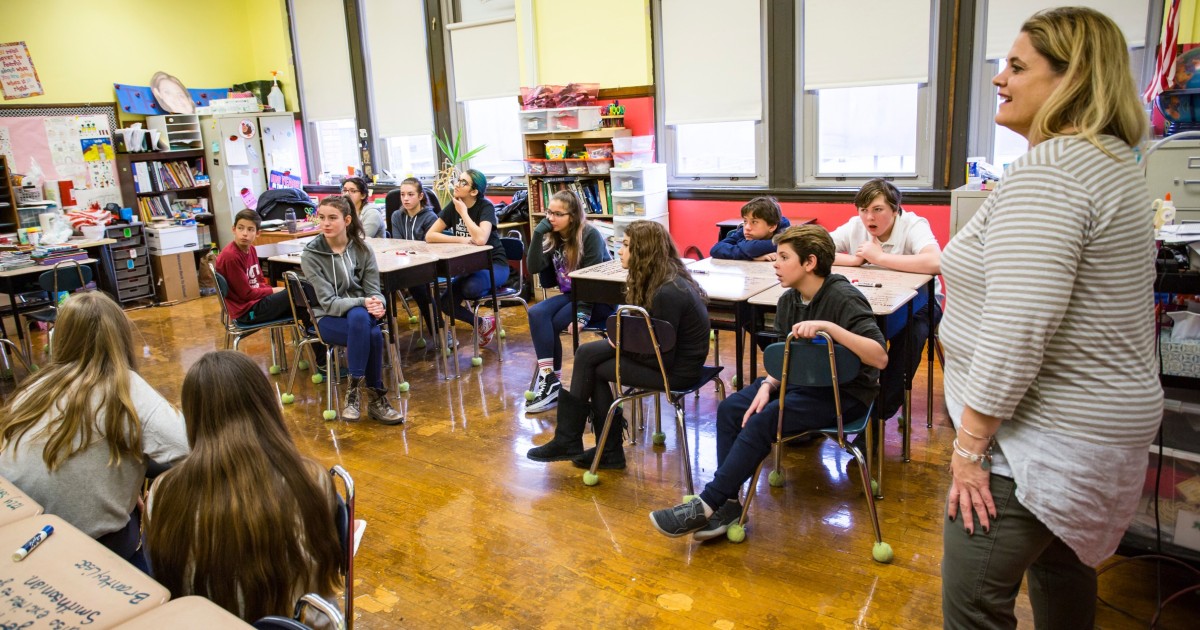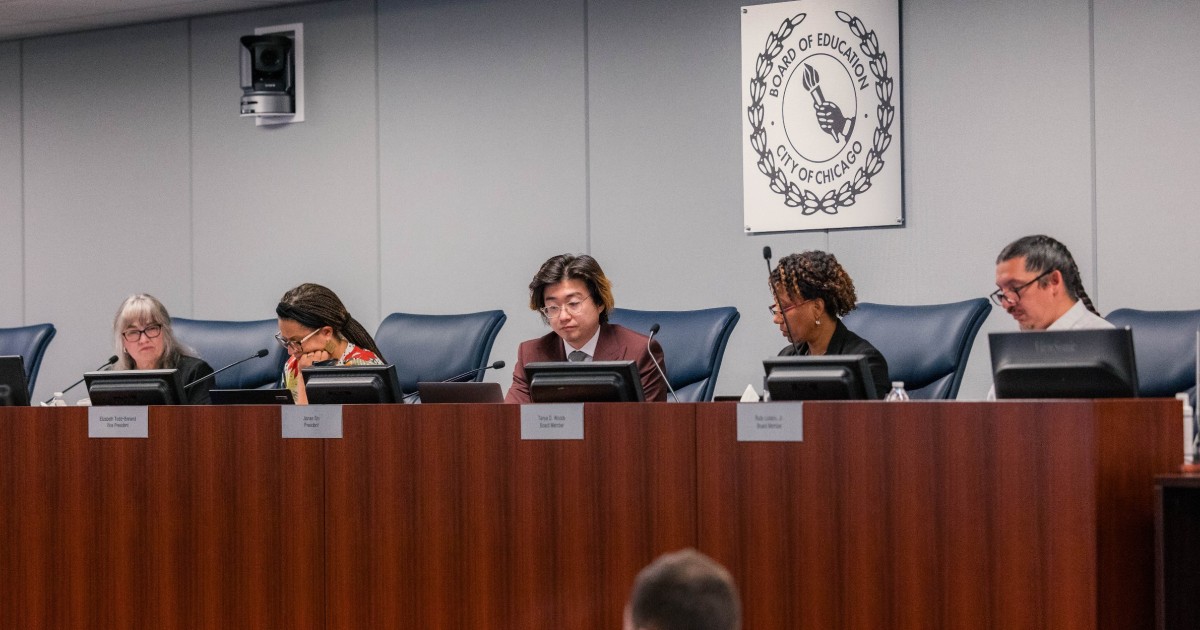We, the People of the State of Illinois - grateful to Almighty God for the civil, political and religious liberty which He has permitted us to enjoy and seeking His blessing upon our endeavors - in order to provide for the health, safety and welfare of the people; maintain a representative and orderly government; eliminate poverty and inequality; assure legal, social and economic justice; provide opportunity for the fullest development of the individual; insure domestic tranquility; provide for the common defense; and secure the blessings of freedom and liberty to ourselves and our posterity - do ordain and establish this Constitution for the State of Illinois.
Can you pass an eighth grade Constitution test?
Take our 15-point quiz on the Illinois and U.S. constitutions, based on real questions students face.
To graduate from eighth grade, Illinois public school students have to pass a “Constitution test” covering the U.S. and Illinois constitutions.
Because schools design their own exams, many are shifting away from more traditional multiple choice tests in favor of short, written answers or other assessments that stress critical thinking. Many school districts, including Chicago’s, are focusing their civics education toward helping students understand their role as actors in shaping democracy, beyond just dates and facts.
The quiz here is decidedly traditional: Answer nine out of 15 true-false questions correctly to pass. It includes questions teachers have relied on to make their constitution tests, including in Chicago public schools. Below the quiz you’ll find a short-answer test, one example of the new format Chicago Public Schools recommends.
You got 0 out of 15 questions correct
1. Illinois became a state in 1848 and was the 21st state.
2. Both the Illinois Constitution and the United States Constitution have a Bill of Rights.
3. The 10th Amendment of the U.S. Constitution recognizes the power of states.
4. The biggest item in state spending is for highways.
5. Most Illinois court cases take place in the circuit courts.
6. The original 13 colonies included Kentucky.
7. The U.S. Constitution allows for laws to be made on subjects that did not even exist in 1787.
8. Your state legislature has the same lawmaking scope as the U.S. Congress.
9. The U.S. House of Representatives has nothing to do with the impeachment of a president.
10. The Declaration of Independence was the nation’s first Constitution.
11. The Bill of Rights are the first 10 amendments to the U.S. Constitution.
12. The U.S. Supreme Court justices are appointed by Congress.
13. The Declaration of Independence came before the signing of the U.S. Constitution.
14. States can make treaties with foreign countries.
15. Federalism is the sharing of power by the federal government and state governments.
Source: Our Federal and State Constitutions, by Alex J. Schmidt and Steven H. Schmidt. AJS Publications, printed with permission.
Congrats on completing the traditional Constitution test! Below, check out a new kind of Constitution test, one that Chicago Public Schools prefers its teachers use these days. The school district's civics education curriculum is focused on moving beyond facts alone and helping students understand how they can help shape democracy.
Take a look at one of CPS’ new constitution tests.
1. What is the purpose of the Preamble [to the U.S. Constitution]? Make a connection between the language of the Preamble and one of the democratic principles embodied in the Constitution.
CPS sample answer: The Preamble describes the purposes and functions of the government established in the Constitution. The words “We the People” set out that it is the people that are establishing the Constitution. Thus, those words connect to the principle of popular sovereignty — the idea that the people hold the power in our democracy. Another principle linked to the Preamble is individual rights — to secure the blessings of liberty to ourselves and our posterity means to protect the rights and freedoms of not just ourselves but future generations.
2. Describe at least two methods the framers of the Constitution used to ensure government power is limited.
CPS sample answer: One method of limiting government power is separation of powers. By dividing power among different branches and levels of government, the Constitution prevents any branch or level of government from becoming too powerful. Another method is by giving people the right to trial by jury and the right to a fair process when accused of a crime. This prevents the government from simply throwing people in jail without probable cause.
3. How are the Illinois and U.S. constitutions alike? What is one way they are different?
CPS sample answer: Both the Illinois and U.S. Constitutions establish a republican form of government (or representative democracy). The people elect representatives to make policy for them. Both constitutions establish a government with three branches — executive, judicial, and legislative. Power is separated between those branches. Both Constitutions have a bill of rights, a list of the rights guaranteed to the people. One way in which they are different is that the Illinois Constitution includes rights not included in the U.S. Constitution.
4. Describe a way in which you, as a civic actor, can influence or interact with each branch of government. Which way of government are you most likely to do?
CPS sample answer: I can influence the legislative branch by writing or calling my representatives, by taking part in a town hall with a representative, or by testifying at a public hearing. I can influence the executive branch by writing to the president or governor or by submitting comments to government agencies when they propose new rules and regulations. I can also influence both of these branches by participating in marches and protests designed to let them know how we the people feel about issues. I can interact with the judicial system by serving on a jury, becoming a lawyer or judge, or filing a lawsuit. I can also write to my senators asking them not to confirm someone the president has nominated to be a judge.
5. Kali and Rodrigo are at home when the police arrive. The police ask to search the home. Kali says “yes,” but Rodrigo says “no.” The police search the home and find evidence of a crime. What right might Rodrigo claim was violated? What might the police say in response? If you were the judge, what would you decide?
CPS sample answer: Rodrigo might claim that his Fourth Amendment rights—protection from unreasonable search and seizure — were violated. The police did not have a warrant, and he denied them permission to search. The police might argue that the woman gave them permission to search and therefore they didn’t need a warrant. Students may take either side as long as they can give a reason. (In reality, that is what would happen in most jurisdictions).
6. A terrible crime is committed. The newspapers and television have many stories about it. When a suspect is arrested, even more stories appear. The suspect’s lawyer is afraid potential jury members will be convinced her client is guilty. She asks the judge to issue a gag order — an order to tell everyone involved with the case to stop talking to reporters. What two rights are in conflict? If you were the judge, would you grant the gag order?
CPS sample answer: The right to a fair trial is in conflict with the rights of free speech and free press. A gag order would stop the attorneys from talking to the press, violating their freedom of speech; it would also stop the press from publishing information about the case, violating freedom of the press. Having a lot of negative information about the person who is accused of the crime could mean members of the public would be prejudiced if asked to serve on a jury; thus, the right to a fair trial would be threatened. Students may take either side as long as they can give a reason.
7. Describe how voting rights have changed over the course of U.S. history. What change would you like to see in voting rights today?
CPS sample answer: At the beginning of our country, only white men who owned property could vote. Voting has expanded since then to include women and people of color. This has happened in different ways. States have changed their laws by, for example, allowing all white men to vote. The Constitution has been amended to give certain groups the right to vote. For example, after the Civil War, the 15th Amendment gave Black men the right to vote. But laws in Southern states made it almost impossible for them to really vote. These laws were overturned by constitutional amendments, lawsuits, and federal laws. Women also got the vote through a constitutional amendment (19th), as did people aged 18-21 (26th). In terms of changes they would like to see today, students might mention mail-in voting, voter ID laws (pro or con), automatic voter registration, voting for 16- and 17-year-olds, etc.
Source: Participate: A Middle School Civics Course for Chicago’s Youth, Chicago Public Schools.
 This project is a part of the Democracy Solutions Project, a joint effort between WBEZ, the Chicago Sun-Times and the University of Chicago's Center for Efffective Government exploring critical issues facing our democracy.
This project is a part of the Democracy Solutions Project, a joint effort between WBEZ, the Chicago Sun-Times and the University of Chicago's Center for Efffective Government exploring critical issues facing our democracy.

